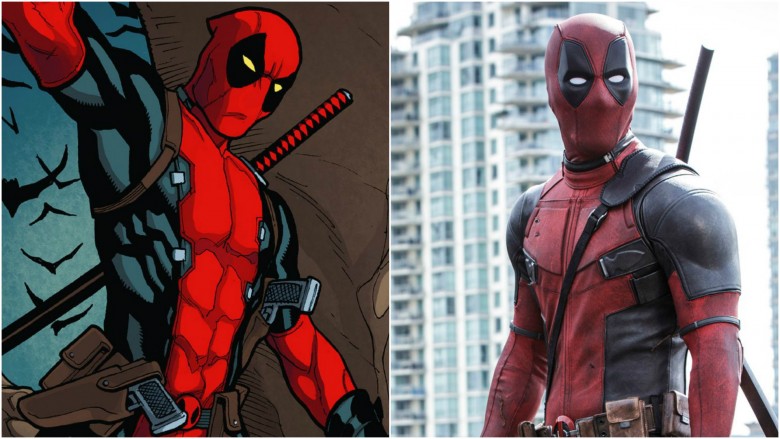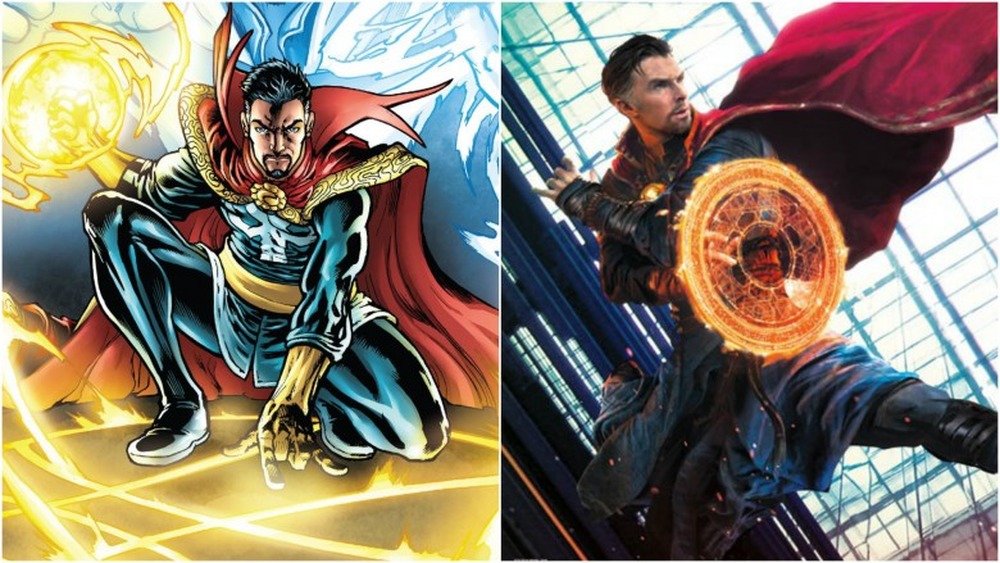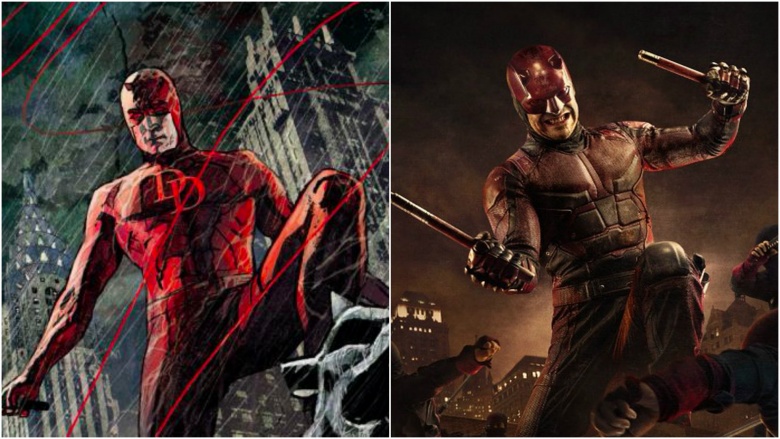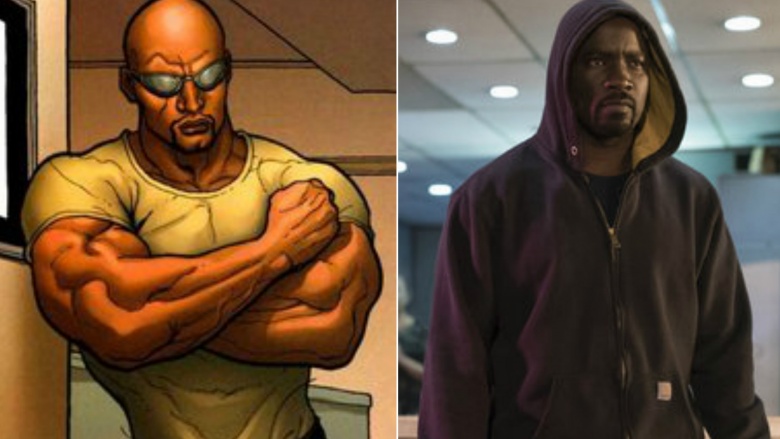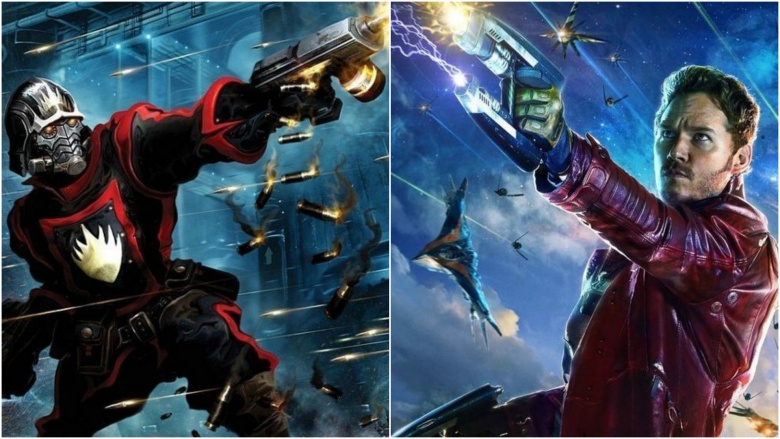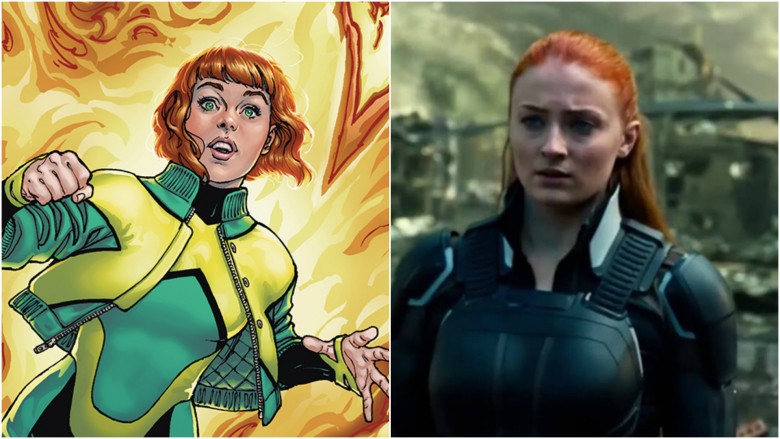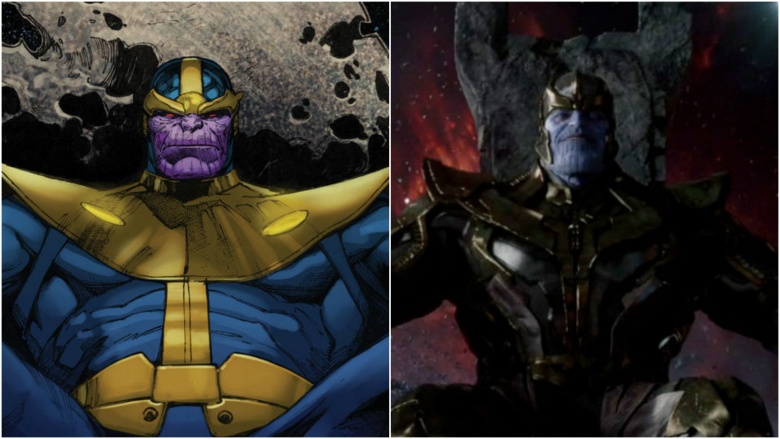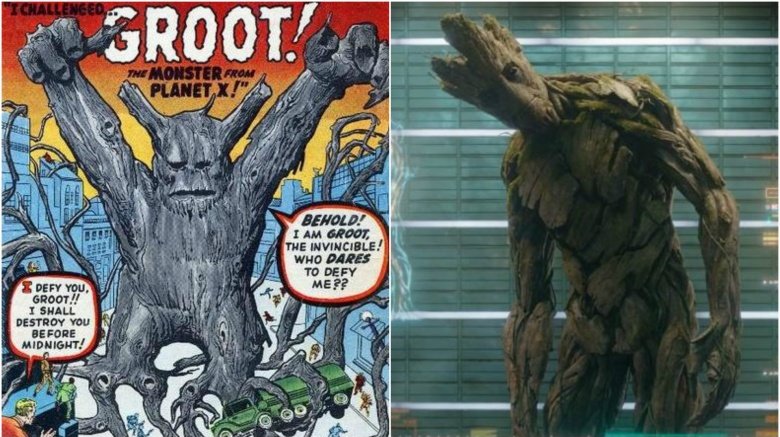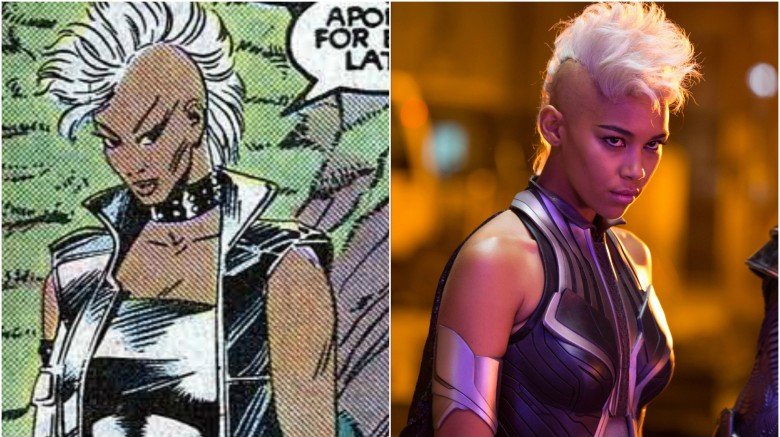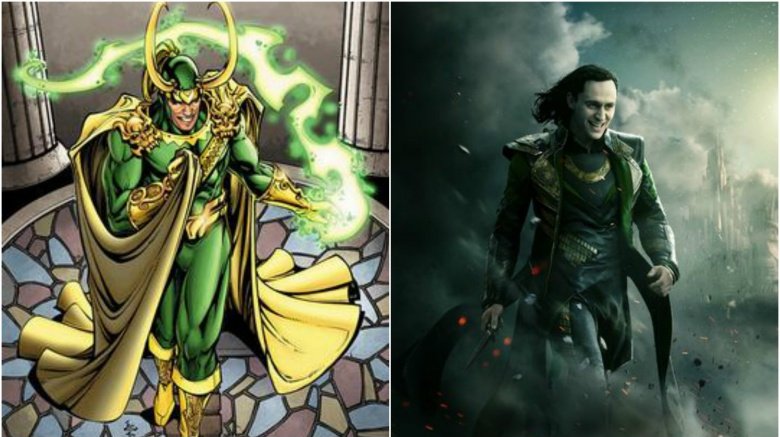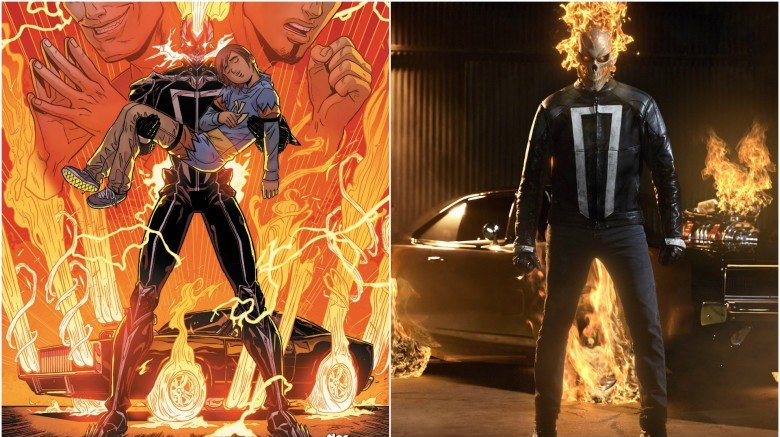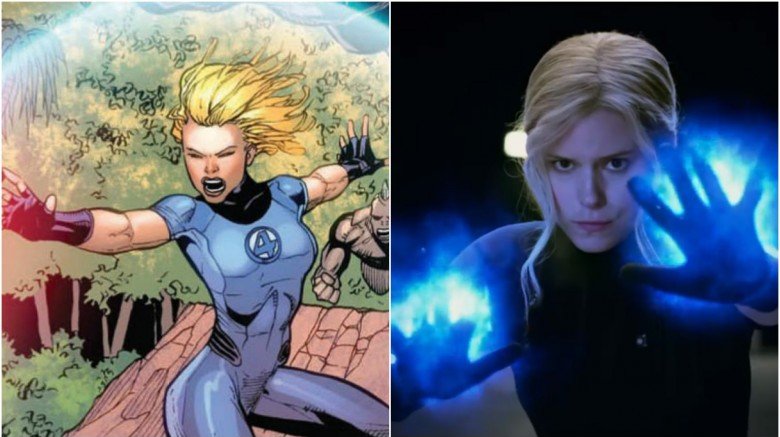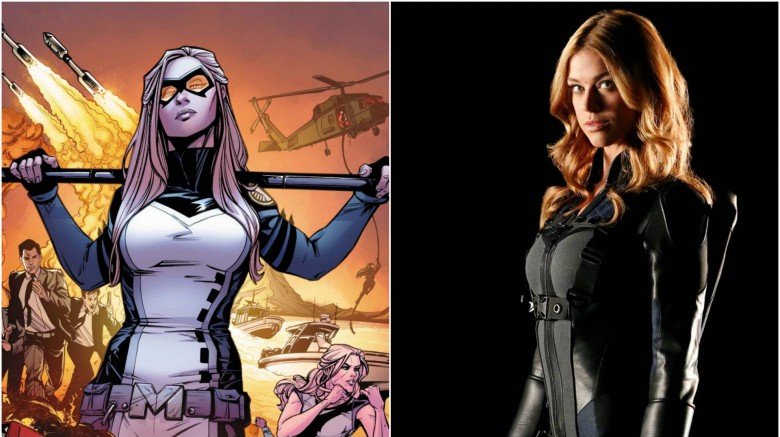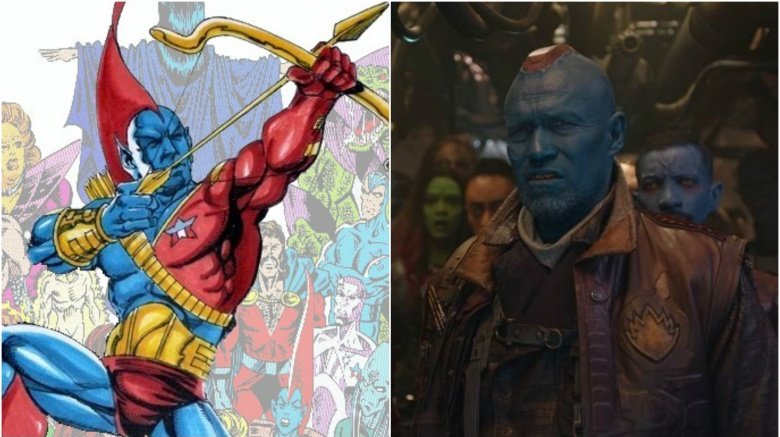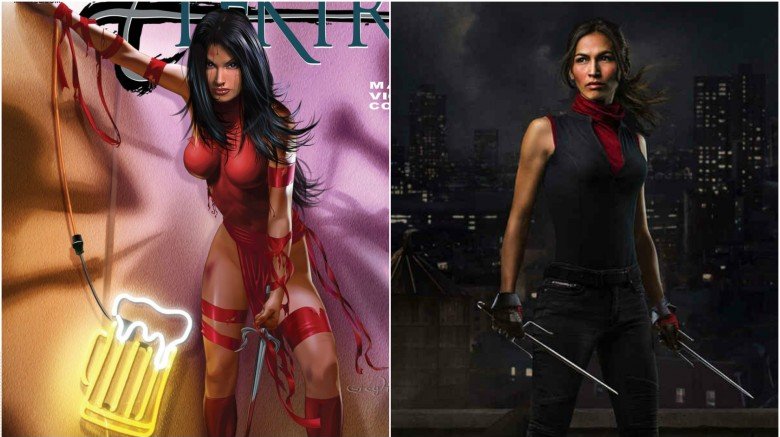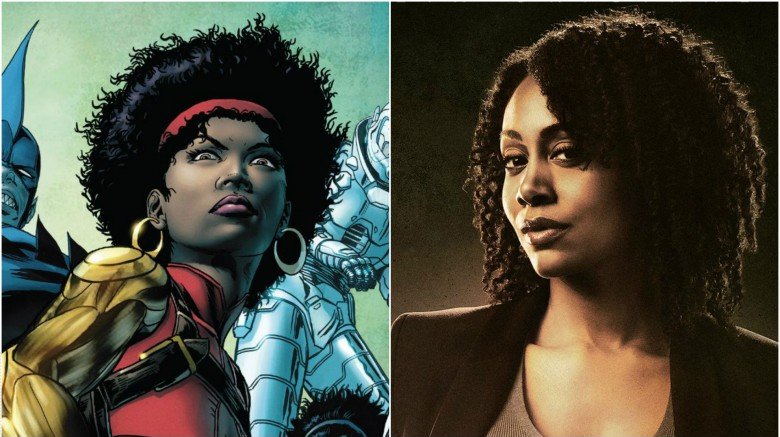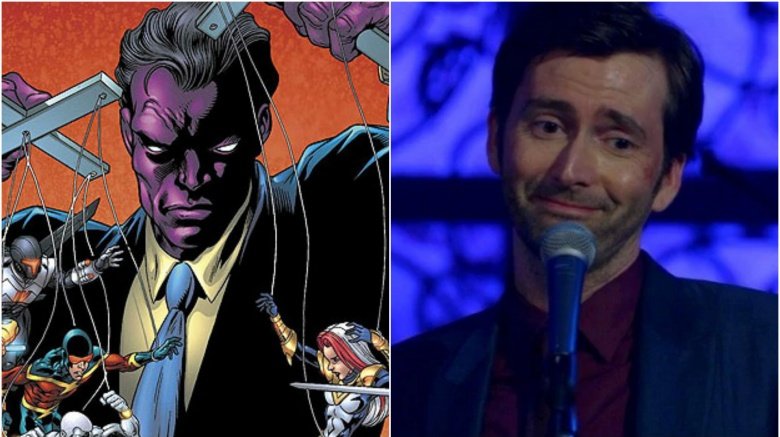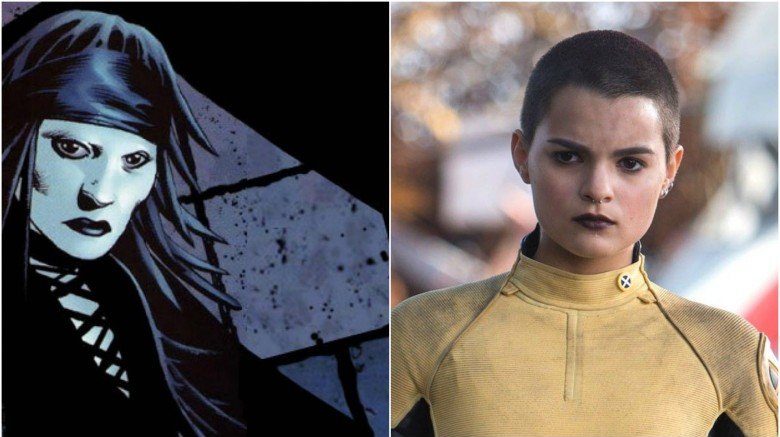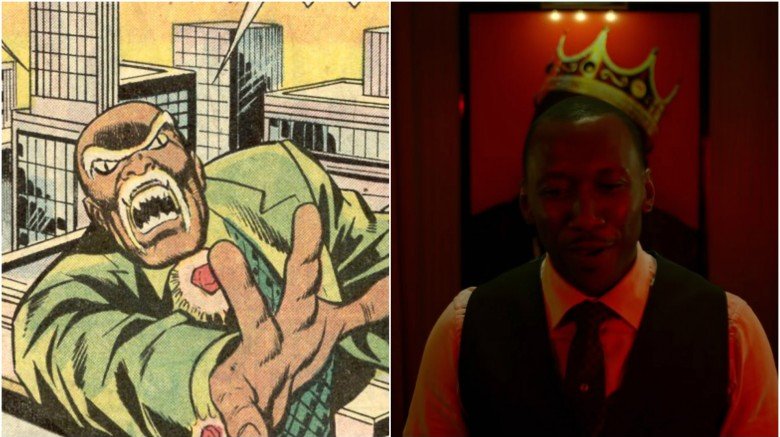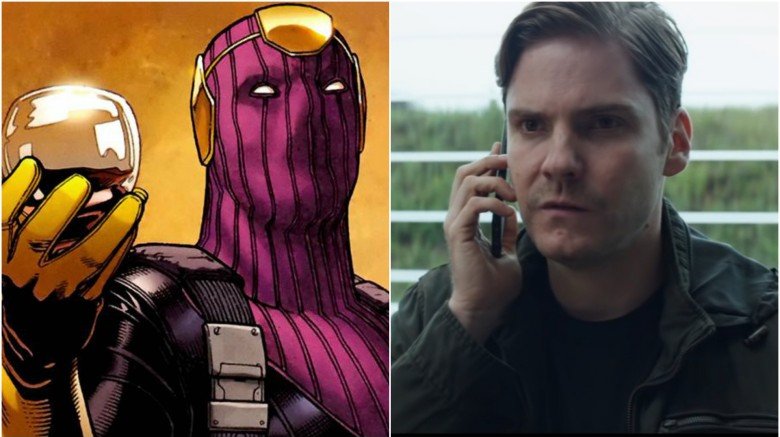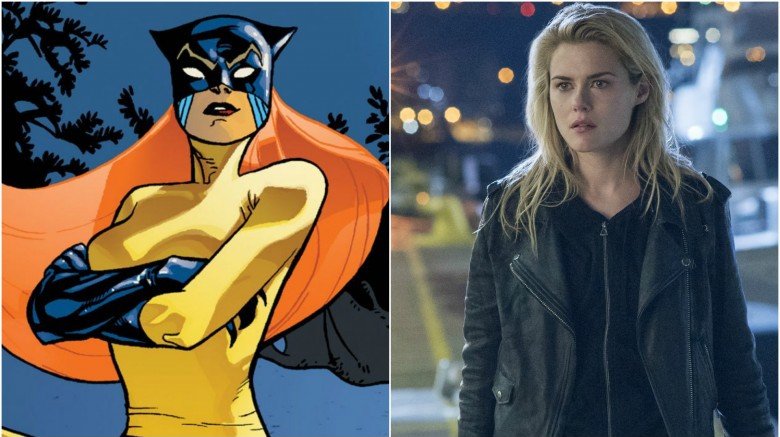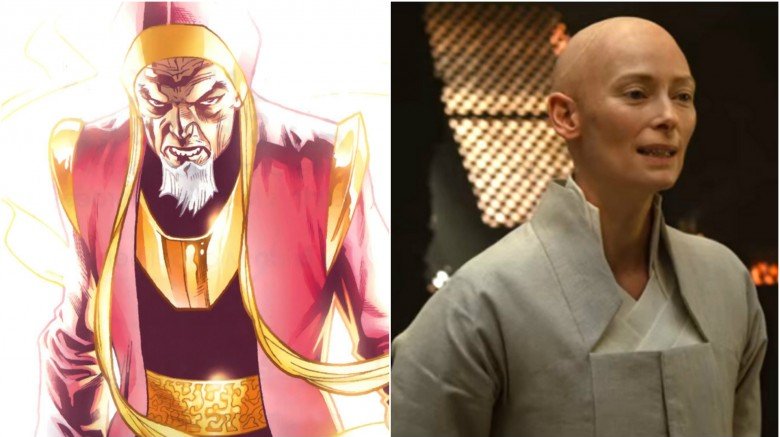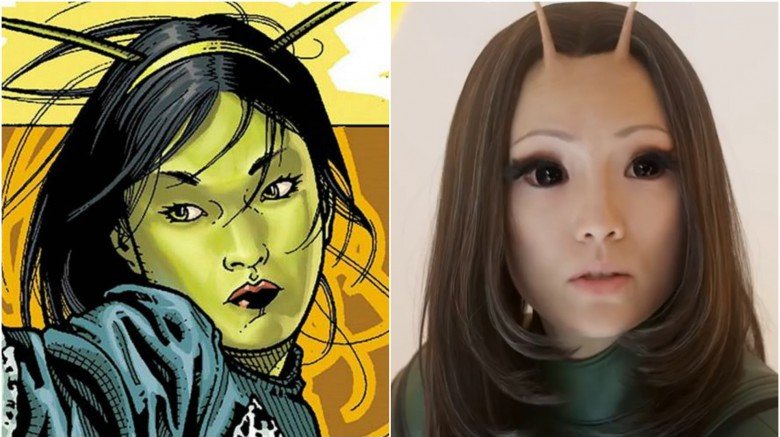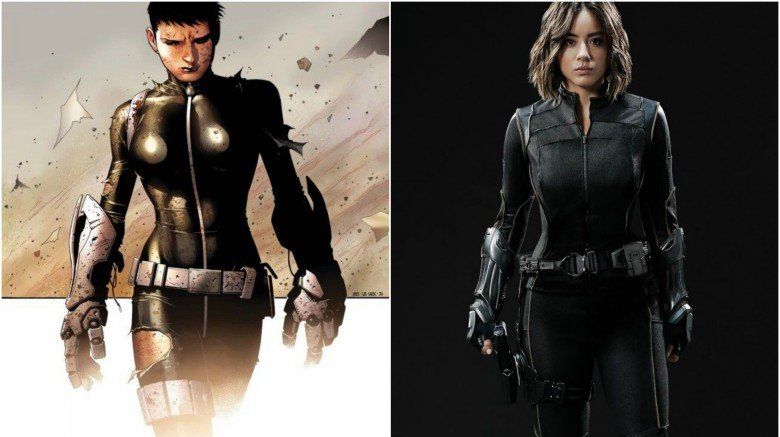How Marvel Characters Should Really Look
We may receive a commission on purchases made from links.
While their DC rivals struggle, Marvel's live-action offerings have gone from strength to strength. But in the course of adapting their comic book properties to film, Marvel have made some pretty big changes to their classic characters. Some were undoubtedly for the best, while others have risked losing the magic that made those characters so beloved in the first place. Either way, it's interesting to see the ways that some Marvel characters were altered in the transition to the silver screen.
Deadpool
After Ryan Reynolds' first outing as Deadpool, fans had a right to be worried. While Deadpool technically appears in X-Men Origins: Wolverine, the fast-talking antihero is practically unrecognizable. Not only is he covered in tattoos, he's got the powers of other mutants—well-known ones, too, including the X-Men's leader, Cyclops—and, most egregiously, his mouth is sewn shut, robbing fans of the Marvel character's trademark wisecracks.
Fans didn't like the changes. Neither did Ryan Reynolds. That's why, when Deadpool returned to the big screen in 2016 for his own feature film, Reynolds and director Tim Miller played everything by the (comic) book. The result is, quite possibly, the all-time most faithful reproduction of a comics costume in a movie. The team even went so far as to film two versions of each scene—one with Reynolds wearing the mask, and one without—to create Deadpool's blank white eyes, which, even as part of a mask, change according to his mood.
Doctor Strange
Aside from a few outliers (we're looking at you, Hawkeye), Marvel Studios has been pretty good about bringing the biggest Marvel characters' outfits to the screen. Iron Man, which kicked off the whole Marvel Cinematic Universe back in 2008, gave fans both a faithful version of Iron Man's power armor and a pitch-perfect Tony Stark in the form of Robert Downey Jr. Captain America may not have wings sticking out of his helmet, but otherwise, his World War II battle get-up is remarkably close to Jack Kirby's original design. And the Hulk, well, he's big and green and wears purple pants. What else do you want?
Add Doctor Strange to that list. The costume Benedict Cumberbatch wears feels almost identical to Steve Ditko's original drawing—and it took a lot of work to make it that way. In a conversation with Slashfilm, Doctor Strange costume designer Alexandra Byrn emphasized the hardships involved in "getting the spirit" of Strange's costume right, even if some of the small details—the size of Strange's collar, or the gold accents on his cloak—aren't quite the same. "You're picking things and balancing them," Byrn says. "You're mixing ideas so that it's true to the story of the comic as well as the story of the film."
Daredevil
A departure from the glitzy, planet-saving exploits of the Avengers, Netflix's Daredevil series kept to gritty, street-level heroics. Naturally, producers were nervous about undermining this realistic approach with red spandex, and Daredevil spent most of the first season fighting crime in cargo pants. A glimpse of his costume at the end of the season revealed some major changes from the comics. Daredevil's famous double Ds were gone, and the vivid red color scheme had been toned down to maroon. Most notably, the traditional skintight superhero costume was ditched in favor of reinforced leather, giving the Marvel character a more armored look than his comics counterpart.
That last change actually ended up causing some problems. While it may look tough, there's a reason you rarely see Olympic athletes compete in leather pants. Spandex gives the wearer a much wider range of motion, making it easier to backflip off a gargoyle and kick a ninja in the face. As a result, a slightly redesigned costume was introduced in season two, which kept most of the new look while making it easier to move around. As Daredevil actor Charlie Cox told IGN, "there were some things that didn't work quite as well, just in terms of maneuverability and comfort...So the lower portion of the suit is slightly baggier, and we go back to the old combat boots as well, which make it easier for me and my stunt double to jump and kick and do all the things you need to do as Daredevil."
Luke Cage
Luke Cage never adopted the skintight getup popular with other superheroes, but his traditional outfit was still pretty goofy, featuring a silver headband and a yellow blouse open to the waist. While that look undoubtedly killed at Studio 54, it didn't outlast the '70s. By 1992 it was considered so cringeworthy that Luke was depicted tearing it in pieces on the cover of his own comic. However, it does get a fun shout-out in the TV series, which sees Luke grab a yellow shirt to wear while still sporting the metallic headpiece and cuffs from the experiment that gave him superpowers.
While most comics artists simply update Luke's original costume into a yellow T-shirt, the Netflix series prefers darker clothes. Luke also wears a lot of hoodies, which wasn't simply an aesthetic choice. Star Mike Colter told MTV News that the dark hoodie was "symbolic because of Trayvon Martin. We talked about that specifically, what that would mean to people and the feelings it would evoke in viewers. Irregardless of the entertainment value, what this show says politically resonates profoundly."
Star-Lord
Although the "Guardians of the Galaxy" name has been around since the '60s, they were never a major part of the Marvel Universe, and the version of the team that inspired the movie actually only debuted in 2008. Since fans weren't particularly attached to such an obscure property, director James Gunn was able to make some pretty big changes to the characters. In the comics, Star-Lord (real name Peter Quill) is an established hero who assembles the Guardians as a kind of galactic police force. They even have spiffy uniforms and a base on the giant severed head Knowhere (home to the Collector in the movie).
Of course, the movie version of Star-Lord is more of a criminal than a cop, which required a drastic costume redesign. The uniform and logo were ditched for a roguish leather jacket and T-shirt combo. The classic helmet was scaled back to a faceplate, giving the Marvel character a less militaristic look. And the bullet-spraying Kree machine guns were switched for some PG-13 blasters. After the movie became a hit, the new outfit was largely imported to the comics, even though it makes less sense for an experienced soldier like the comic book version of Star-Lord.
Jean Grey
When you're talking about Jean Grey's costume, it's important to note which one. Do you mean the yellow and gold bodysuit she donned after joining the X-Men in X-Men #1? Or the green mini-dress and yellow mask she adopted a few years later? And don't forget the sleek green and yellow spandex she put on as Phoenix, the red variation that marked Jean's turn towards the dark side, the Jim Lee redesign popularized by X-Men: The Animated Series, or the jacket-and-tights combo currently worn by Jean's time-displaced doppelganger.
In short, if you're going to bring Jean Grey to the big screen, you have lots of options to choose from—or, y'know, you could just ignore all of it and do your own thing. In the first X-Men movie, director Bryan Singer and his costume designers decided to stick everyone, including Famke Janssen's Jean Grey, in black leather. Things didn't get better in Singer's latest X-Men film, X-Men: Apocalypse. With her bright red hair, Game of Thrones star Sophie Turner certainly looks like the teenage Jean, but in battle, she wears bulky black body armor that looks more like a SWAT team uniform than a fully-fledged superhero costume.
Jessica Jones
As the titular lead in Netflix's Jessica Jones, Krysten Ritter doesn't look exactly like co-creator Michael Gaydos' original drawings, but she gets the attitude right. Like the Jessica that appears in Brian Bendis and Gaydos' original Marvel series, Alias, Ritter's Jones is wary, tough, and has more than her fair share of issues, and she has a casual, no-nonsense wardrobe to match.
It's when Jessica embarks on her short-lived superhero career that the two versions of Jessica differ. In the comics, Jessica (a lifelong superhero fan) decides to become a superhero after she's doused with—what else?—radioactive chemicals, giving her super-strength. As Jewel, Jones sports purple hair and a low-cut, skin-tight, white bodysuit, accented with blue gloves and a sash. In the television show, however, Jessica says no to the spandex immediately—and when Jessica's friend Trish suggests going by Jewel, Jessica retorts by calling it a "stripper's name."
Thanos
Thanos has made a big impact in the MCU, despite standing up for less than 30 seconds so far. This love of sitting ominously is very true to the comics, where the Marvel character's inventively named Space Throne can teleport and travel between dimensions (but doesn't have cool hovering space armrests). Comics Thanos does seem more active than his movie counterpart, who can be heard whining about having to collect the Infinity Stones himself during his post-credits appearance in Age of Ultron. Compare that to the comic book Thanos, who was once spotted whizzing around New York in a personalized helicopter, pushing over children.
Thanos's costume has been updated to give him a more armored look, replacing the skintight space spandex beloved by comics artists everywhere. The blue-and-gold color scheme remains, but is somewhat muted, and the helmet is now a separate piece instead of being connected to the neck plate. The character's traditional purple complexion actually did make an appearance in The Avengers, but was replaced with a milder blue by Guardians of the Galaxy. Perhaps he just needs to work on his tan.
Apocalypse
While X-Men big bad Apocalypse first appeared in X-Factor, a series that reunited the original X-Men team (Cyclops, Beast, Iceman, Angel, and Jean Grey), an entire generation of fans knows him best for the sprawling Age of Apocalypse crossover that took over the X-books in March of 1995. Age of Apocalypse, which takes place in an alternate timeline in which Apocalypse rules the world, encapsulates the best and worst of the mid-'90s X-Men franchise—bursting at the seams with overly elaborate costumes, angsty characters, and way too many plot holes, but still a lot of fun.
That's why fans had high hopes for X-Men: Apocalypse, Bryan Singer's '80s-set sequel to Days of Future Past, but they started tempering their expectations almost immediately after seeing the first picture of Oscar Isaac's Apocalypse. In the final film, Apocalypse is blue (not purple, like some people feared), but that's setting aside the fact that the comic book Apocalypse is mostly grey—the blue highlights his jaw, lips, and armor. Apocalypse's on-screen outfit also looks older and more ornate than the comic book's sleek, tech-heavy design—likely due to the film's focus on Apocalypse's Egyptian origins.
For the record, Isaac didn't like his costume either, although for different reasons: Isaac's prosthetics weighed over 40 pounds and filled his ears with sweat, leading to a miserable filming experience.
Groot
Perhaps no Marvel character has changed quite so drastically as Groot over the years. While he remains a tree creature from space, the current Groot bears little resemblance to his original characterization as a gigantic monster with a tendency to scream out his evil plans for all to hear. This won him no respect at all—in his first appearance, he was defeated when some random guy doused him with termites. He was eventually retconned as a hero who could only speak the words "I am Groot," which was a substantial improvement over his original dialogue.
However, the comic version of Groot retained a fairly sinister appearance and an obviously keen intelligence. For the movie, the character was redesigned to emphasize his kindness and innocence. His snarling mouth was abandoned and he was given human-like eyes instead of the glowing orbs he boasted in the comics. As a result, it's hard to imagine anyone being scared of movie Groot, while his comics counterpart is still sometimes a terrifying space monster.
Storm
Thanks to X-Men: The Animated Series, Storm's most memorable outfit is probably her early '90s ensemble, which features skin-tight white spandex, wind-blown hair, and a flowing cape, all of which cut a pretty silhouette when Storm takes to lightning-filled skies. Over the years, however, Storm has sported a number of different looks. Writer Chris Claremont, who helmed the X-books for over 17 years, changed Storm's hair regularly in order to show her growth as a character. At one point, that meant she ditched her regal robes and long locks for a punk-rock-inspired all-leather get-up, complete with a mohawk.
That's the costume that inspired Storm's look in X-Men: Apocalypse (and which, not coincidentally, returned in the comic books right around the time the movie debuted). It's not a perfect translation, of course: Singer gives Storm her cape back, and her metal bracers seem more in line with her role as an African weather goddess than a punk rocker. Still, it's a more faithful adaptation than the generic leather jumpsuit and white wig that Halle Berry had to endure during her four outings as the X-Men's occasional leader.
Loki
Despite its dramatic success, the Marvel cinematic team has struggled to create memorable villains. A notable exception is Tom Hiddleston's Loki, who won plaudits as the conflicted bad guy in Thor and The Avengers. The classic Marvel character has mostly stuck close to the source material, although he has yet to match his comic equivalent's gleeful mischievousness (it's hard to imagine movie Loki turning Thor into a frog, for example). As such, his costume remains fairly faithful to the comics. Even his famous horned helmet makes a few appearances.
The main change is the same one most comics adaptations make: switching Loki's classic skintight catsuit for something a little less revealing. The costume has also been toned down a little, with darker greens and less vivid gold trimmings. That said, Loki is a character who has never been afraid to change his appearance, spending large periods of the comics as a child, woman, or bird, so it's hard to say for sure what the character should really look like.
Ghost Rider
If you only know Ghost Rider from his early comic book appearances or the two Nic Cage flicks—you know, the ones in which Ghost Rider literally pees fire—you'll notice that, despite the flaming skull, the Agents of S.H.I.E.L.D version of the Marvel character is pretty different, particularly in his choice of transportation. On the small screen, Ghost Rider gets around in a muscle car—not a motorcycle, the wheels of choice for the classic comic book version.
As it turns out, Agents of S.H.I.E.L.D is actually in the clear. While Johnny Blaze, a motorcycle stuntman turned spirit of vengeance, is the most well-known Ghost Rider, he's not the only one. In 2014, a young man named Robbie Reyes took up the Ghost Rider mantle, and he's held it ever since. According to S.H.I.E.L.D.'s producers, Robbie's backstory fit better with the show's familial themes, while Robbie's relatively brief publishing history gives S.H.I.E.L.D.'s writers more room to play.
As far as the costume goes, Agents' Ghost Rider gets close to Robbie's original look. The racing suit has been replaced with a Johnny Blaze-like leather jacket and jeans, but the overall vibe is pretty much the same—except for Ghost Rider's signature flaming skull, which is robotic in Robbie's comic book interpretation as a reference to Robbie's auto mechanic past.
Sue Storm and the Fantastic Four
Sometimes, 2015's Fantastic Four gets Sue Storm's look just right—after all, when you're invisible, it doesn't matter what you're wearing. When the Invisible Woman isn't using her powers, however, things get a little dicier. In Jack Kirby's earliest Fantastic Four comics, the super-family wore suits made from "unstable molecules," which allowed them to use their powers without ruining their duds. While many artists gave the Fantastic Four their own touches in the half-century or so after Fantastic Four #1 hit newsstands, the basics behind Kirby's designs—the bright blue hue, the circular "4" logo, and the lab-suit inspired gloves and boots—have remained fairly consistent.
The 2015 reboot, however, took things in a different direction. Director Josh Trank wanted to tell "a Cronenberg-ian science fiction tale of something horrible happening to your body and [it] transforming out of control," not a family-focused, sci-fi adventure story. In a setting like that, the brighter costumes just wouldn't work. "It wouldn't make sense," star Miles Teller argued. "We don't really become a team, for the most part ... we're a government experiment." A sad result for fans, for sure, but at least old Benjamin Grimm—better known as the Thing—ended up looking pretty much perfect.
Mockingbird
In the comics, Bobbi Morse—codename Mockingbird—is the ex-wife and on-again, off-again squeeze of big-time Avenger Hawkeye. However, that wouldn't work on television. Not only is Jeremy Renner, who plays Hawkeye in the Marvel Cinematic Universe, a busy movie star (although, reportedly, he'd be up for a visit to S.H.I.E.L.D. headquarters), but rumored tensions between Marvel's movie and TV divisions mean that a crossover of that magnitude is fairly unlikely. (Plus, the MCU's Hawkeye is a happily married father.)
Instead, when Agents of S.H.I.E.L.D. brought Mockingbird into the fold, they gave her a new love interest. Lance Hunter, played by Nick Blood, had instant chemistry with Mockingbird actress Adrianne Palicki, and the pairing worked so well that ABC considered giving the crimefighting duo their own show. Bobbi's love life isn't the only thing that changed in the transition to the small screen, either. Traditionally, Mockingbird wears a black and white catsuit, with metal gauntlets and either a mask or goggles. Onscreen, Palicki sported a dark, padded jumpsuit that fits in better with S.H.I.E.L.D.'s super-spy aesthetic—but, thankfully, she did get to keep Bobbi's signature weapons, her dual batons.
Yondu
As far as Marvel characters go, Yondu Udonta is a deep cut. A member of the original 1960s Guardians of the Galaxy, the character was basically a racist Native American stereotype, albeit transplanted into space and given a head fin. A mystical hunter, Yondu had a spiritual connection to nature and could sense disturbances in the local ecosystem. Instead of technology, he relied on his bow and a set of sound-sensitive arrows he could steer by whistling. His usual costume was a loincloth and some decorative belts.
The movie version of Yondu couldn't be more different. He's a crass space pirate who lies, steals, kidnaps children, and collects dolls. Since Yondu's original look doesn't exactly scream "tough guy," this required a complete redesign. The biggest change is his head fin, which becomes a high-tech implant that allows him to control his arrow. The arrow itself can move under its own power, removing the need for Yondu to lug a bow around. Although the character will sport a bigger fin in the second movie, it's still clearly a metal implant, suggesting Yondu isn't going to be hunting space buffalo any time soon.
Elektra
The second season of Daredevil isn't the first time Élodie Yung has played a red-clad ninja warrior. In 2013, Yung appeared as Jinx in G.I. Joe: Retaliation, and while her loose red outfit doesn't look exactly like Frank Miller's iconic Elektra costume, it's pretty darn close.
Closer, maybe, than Yung's look as Elektra herself. While Jinx wears a blindfold that recalls Elektra's headscarf, Yung's Elektra leaves the top of her head uncovered. That's not the only change, either. Daredevil replaces Elektra's flowing red robes with a considerably more modest jeans and vest, while the red is reduced to a highlight in order to help Elektra—who is, after all, a trained assassin—blend into the night. That doesn't stop Daredevil from making slight nods to Elektra's comic book origins, particularly when Elektra goes undercover in a slinky red dress, but on the whole, Yung's outfit is a whole lot more practical than Miller's original design.
Misty Knight
There is, quite literally, more Misty Knight in Netflix's Luke Cage than there is in the original comics: while both versions of Knight are skilled combatants and dogged crimefighters, Marvel Comics' Misty is missing her right arm.
You wouldn't necessarily know that just to look at her, of course. Shortly after Misty suffered an injury while serving as a New York City police officer, she received a bionic prosthetic courtesy of Tony Stark, the billionaire inventor better known as Iron Man. The mechanical arm, which gives Misty super-strength and a variety of technology-based powers, allowed Misty to return to the front lines on the war against crime—following her retirement from the police force, Misty teamed up with her friend Colleen Wing and entered the private detective business.
Over on Luke Cage, Misty remains a member of the NYPD and wears outfits befitting her position (her print-based counterpart prefers outfits inspired by the '70s blaxploitation craze). Despite a late-season arm injury, Netflix's Misty still has all of her limbs intact, although actress Simone Missick teases that could change: "Historically she has a bionic arm, and so you may or may not see that." If it happens, it'll probably be on Marvel's upcoming crossover series The Defenders, which will feature Missick and Misty's return to the Marvel Cinematic Universe.
Killgrave
The nemesis of Jessica Jones, the Purple Man is arguably one of Marvel's most terrifying villains. Originally a spy named Zebediah Killgrave, a chemical accident turned his skin purple and gave him the ability to command complete obedience to his every word. In the Jessica Jones Netflix series, the Killgrave character keeps his mind control powers, but loses the comic book backstory. The Purple Man nickname is never mentioned, and even "Killgrave" turns out to be an alias used to hide his sinister true identity: Kevin Thompson.
The most obvious change is that Kevin doesn't have purple skin and hair. As well as saving on makeup, this grounds the Marvel character in the real world and actually makes him more terrifying: the Purple Man is obviously a monster, but Kevin looks like everyone else, hiding his nightmarish powers in plain sight. The change also helps clear up the plot hole of how the Purple Man avoids arrest, since people should constantly be taking pictures of the weird purple gentleman sauntering down the street. Presumably he could shout "don't tell anyone you saw me, the Purple Man" wherever he goes, but after a while this would start to distract from the story. It's easier just to make him look like a perfectly unremarkable evil British guy.
Negasonic Teenage Warhead
When writers Paul Wernick and Rhett Reese cast Negasonic Teenage Warhead as one of Deadpool's reluctant sidekicks, it wasn't because they were huge fans of the Marvel character. They just liked the name. In New X-Men #15, Negasonic (real name Ellie Phimister) is a psychic who warns Emma Frost about an impending attack on the mutant nation Genosha shortly before dying at the hands of the mutant-hunting Sentinels (and, in the grand, X-Men tradition, she's returned to life and died again a few times since). In Deadpool, Negasonic Teenage Warhead is an X-Men trainee with a razor-sharp attitude and the ability to transform into a living explosive.
Basically, while they share a name, these two versions of Negasonic Teenage Warhead are completely different characters, and there's no reason they should look the same. In New X-Men #115 and subsequent appearances, Negasonic Teenage Warhead is a pale, gothy teenager with a big headband, flowing black clothes, and long hair. By contrast, in Deadpool, she's practically bald, with a punk-style buzz cut, a handful of piercings, and a retro yellow-and-black X-Men uniform.
Cottonmouth
If any one actor ruled 2016, it was Mahershala Ali. As Remy Denton on House of Cards, Ali scored Best Guest Actor nominations from both the Emmys and the Critics Choice Awards. He racked up even more accolades as Juan in the awards-season favorite Moonlight, and won over audiences with a supporting role in the well-received historical drama Hidden Figures. But that's not all: Ali also stole every scene he was in as Cottonmouth, an ambitious Harlem gangster who makes Luke Cage's life hell in Luke's eponymous Netflix series.
Ali's Cottonmouth is very much his own character, too. While the Luke Cage villain's look veers closer to his comic book roots than it might seem at first—Marvel comics has another Cottonmouth who dresses up in a giant snake suit, but that's not actually the same character—Ali's version is more stylish than his pen-and-paper inspiration. In Marvel's print universe, Cottonmouth wears a flashy green suit straight out of a '70s blaxploitation flick, and has sharp fangs and a huge, drooping white moustache that recall his serpentine namesake. Ali's Cottonmouth forgoes the comic's pageantry for smart, subtle suits and restrained facial hair, preferring to deal with his opponents with his restrained wit and the veneer of respectability.
Baron Zemo
Zemo isn't the first villain that's challenged the Avengers on the big screen, but he's arguably the most formidable—after all, while other bad guys couldn't defeat the mightiest Marvel superheroes, Zemo tore the team apart in Captain America: Civil War.
He did it without his comic book counterpart's signature mask, too. As two of Captain America's most feared villains, the original Baron Zemo (a Nazi in World War II) and his son cover themselves in regal purple and gold outfits that hide their faces, and often accessorize with capes, furs, and giant swords. In Civil War, Zemo is just a regular guy who lost his family during The Avengers: Age of Ultron's climactic battle scene. Civil War's screenwriters know that the on-screen Zemo doesn't look or act much like his comic book inspiration, and even considered changing his name—but ultimately decided that "Zemo" was a "fun" nod for comic book fans and kept it anyway.
Patsy Walker
Believe it or not, Patsy Walker is one of the oldest Marvel characters, pre-dating the Fantastic Four, the Hulk, and even the Marvel Comics name itself. Back in 1944, when Marvel was known as Timely, a Patsy Walker debuted in Miss America Magazine #2, where she headlined a teenage romantic comedy. Before long, Patsy had her own book, which lasted into the '60s—it wasn't until the '70s that Patsy reemerged as Hellcat, who gained superpowers by wearing her cat-themed costume.
When Jessica Jones' writing staff reimagined Patsy Walker as Trish, a talk-show radio host and Jessica's best friend, they made her the former child star as a reference to the character's rom-com past. However, while Jessica Jones shows Trish (played by Rachael Taylor) training in Krav Maga, neither her red hair nor her superhero origins made their way onto the show—and, as a result, neither did Patsy's bright yellow outfit.
The Ancient One
When Marvel Studios cast Tilda Swinton—a white woman—as Doctor Strange's mentor the Ancient One (traditionally, a Tibetan man), outrage followed. On one side, Doctor Strange's director argued that the Ancient One's comic book portrayal "is a very old American stereotype of what Eastern characters and people are like" and that the character needed to be updated to better fit modern sensibilities. On the other, Asian actors and Asian-American advocacy groups accused Marvel of "whitewashing," or making minority characters white in big-screen adaptations because, as actress Kelly Hu describes it, studio executives "think that Asian actors and actresses don't pull in the numbers" needed to make a big-budget blockbuster profitable.
Either way, the end result is an Ancient One that looks very, very different from the one comic book fans already know. Swinton shaved her head for the role and wears a bizarre yet simple robe. Under Steve Ditko's pen, however, the Ancient One has a long beard, a coat with large, flowing cuffs, and a Pope-like headdress. There's the issue of gender, too: while the original Ancient One is very, very male, Swinton says that her Marvel character is more androgynous. "We use the term 'her' and 'she' in the film," Swinton explains, "but, other than that, it's very androgynous. Because it doesn't matter."
Mantis
Mantis, a former Avenger and supporting character in Guardians of the Galaxy Vol. 2, wasn't always green. Half-Vietnamese and half-German, Mantis originally looked a lot like any other human (well, any other human trained as a martial artist and psychic by a group of pacifist aliens, anyway). She didn't turn green until creator Steve Englehart unofficially moved her to DC Comics for a single-issue appearance in Justice League under the name Willow. When Mantis eventually found her way back to Marvel (by way of Englehart's Scorpio Rose at Eclipse Comics, in which she was called Lorelai), the color stuck.
However, in Guardians of the Galaxy Vol. 2, Mantis looks like she's changing again. In Marvel's action-packed space drama, Mantis is a pale, otherworldly white, most likely because the Guardians already have one green female on the team. She's also a lot less human-looking than her comic book counterpart, with big black eyes and glowing tips on the ends of her antennae, and it wouldn't be surprising if Gunn decided to simplify Mantis' complicated origin story by making her a full-blooded alien.
At least Mantis' empathetic powers look to be staying around. In the latest version of The Guardians of the Galaxy, Mantis uses her abilities to serve the Guardians' counsellor. Similarly, a scene in which Mantis reads Star-Lord's mind is one of the highlights of Guardians of the Galaxy Vol. 2's first full trailer.
Quake
When Agents of S.H.I.E.L.D. first debuted, fans had one big question. Given that S.H.I.E.L.D.'s cast was comprised of original characters, how long would it take for an established Marvel superhero make the transition from the comic books to Marvel Studios' first live-action television show?
As it turns out, it only took one episode—we just didn't know it at the time. In the pilot, Chloe Bennet plays Skye, a renegade hacker who's brought into S.H.I.E.L.D. by the Marvel Cinematic Universe's busiest secret agent, Phil Coulson. During Season 2, Skye—presumably an orphan—learns that her real name is Daisy Johnson, and that her parents (including the villainous Calvin Zabo, a.k.a. Mr. Hyde) are still alive.
That's the name and backstory of the Marvel character Quake, who also happens to be a S.H.I.E.L.D. agent, and it's not long before Skye has the same vibration-based powers as her comic book inspiration. Skye even adopts Daisy's look: her hair may not be as short, and her power-controlling gauntlets are more subtle than the mechanical monstrosities strapped to Daisy's wrists, but overall? It's pretty close.
